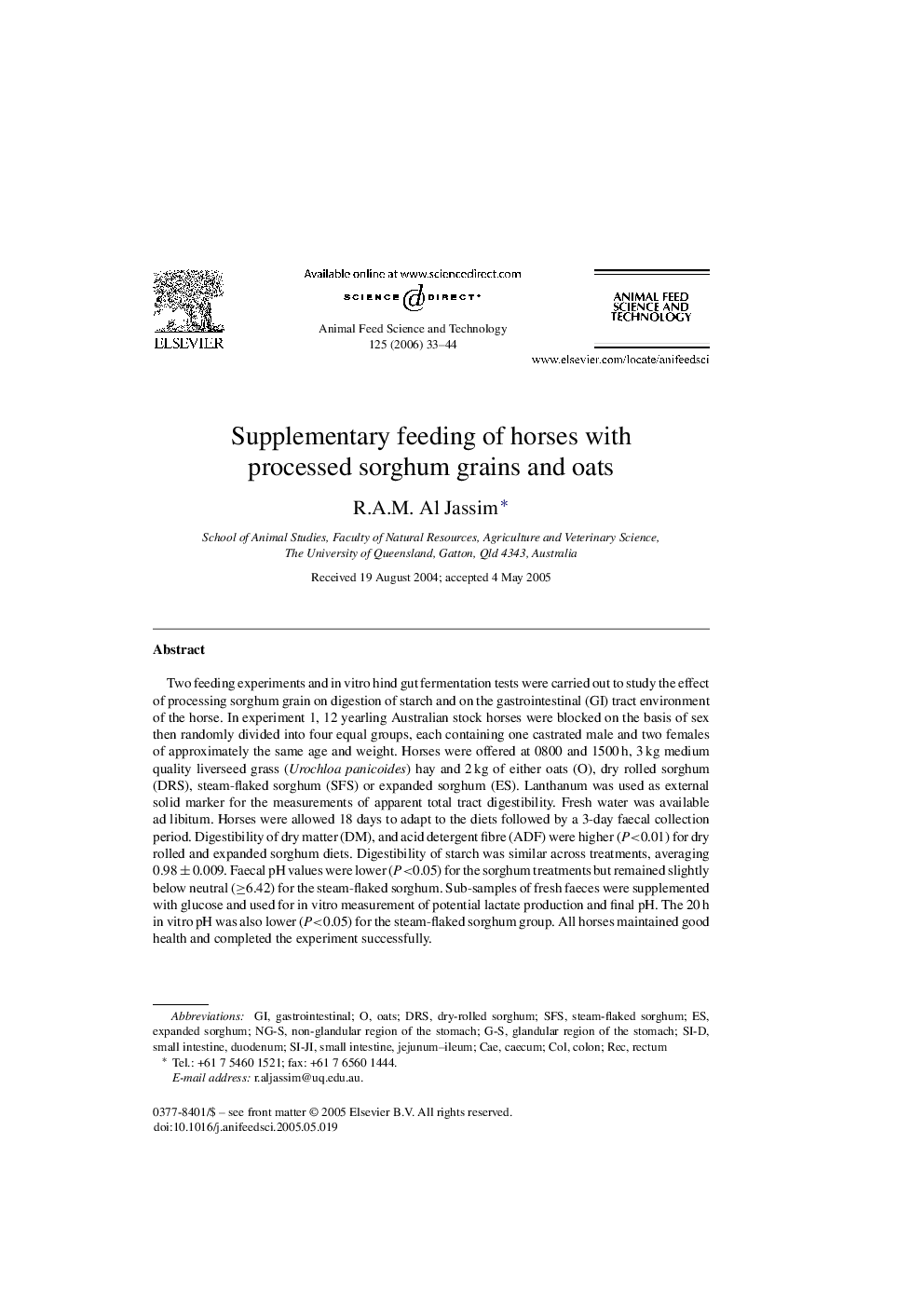| کد مقاله | کد نشریه | سال انتشار | مقاله انگلیسی | نسخه تمام متن |
|---|---|---|---|---|
| 2421291 | 1552505 | 2006 | 12 صفحه PDF | دانلود رایگان |

Two feeding experiments and in vitro hind gut fermentation tests were carried out to study the effect of processing sorghum grain on digestion of starch and on the gastrointestinal (GI) tract environment of the horse. In experiment 1, 12 yearling Australian stock horses were blocked on the basis of sex then randomly divided into four equal groups, each containing one castrated male and two females of approximately the same age and weight. Horses were offered at 0800 and 1500 h, 3 kg medium quality liverseed grass (Urochloa panicoides) hay and 2 kg of either oats (O), dry rolled sorghum (DRS), steam-flaked sorghum (SFS) or expanded sorghum (ES). Lanthanum was used as external solid marker for the measurements of apparent total tract digestibility. Fresh water was available ad libitum. Horses were allowed 18 days to adapt to the diets followed by a 3-day faecal collection period. Digestibility of dry matter (DM), and acid detergent fibre (ADF) were higher (P<0.01) for dry rolled and expanded sorghum diets. Digestibility of starch was similar across treatments, averaging 0.98 ± 0.009. Faecal pH values were lower (P<0.05) for the sorghum treatments but remained slightly below neutral (≥6.42) for the steam-flaked sorghum. Sub-samples of fresh faeces were supplemented with glucose and used for in vitro measurement of potential lactate production and final pH. The 20 h in vitro pH was also lower (P<0.05) for the steam-flaked sorghum group. All horses maintained good health and completed the experiment successfully.Results of this experiment indicate that digestibility of starch of processed sorghum is comparable to that of oats (0.97 versus 0.98), but processing sorghum grains may produce conditions favourable for lactate production and accumulation.In experiment 2, eight Australian stock horses were used to study changes in pH and accumulation of VFA and lactate in the different parts of the gastrointestinal tract. In this experiment SFS was compared with DRS. Horses were divided into two groups on the basis of sex and body weight. Each group contained two females and two castrated males. The nutritional management of the horses was the same as for the DRS and SFS groups in experiment 1. At the end of the adaptation period horses were slaughtered at intervals of 1.5, 3.0, 4.5, and 6.0 h after morning feeding, one horse per interval per treatment. Samples were collected from the different anatomical regions, and analysed for pH, VFA, and l- and d-lactate. Fermentation in the pre-glandular stomach produced mainly lactic acid and reduced pH to 4.0–4.3 while VFA was the main product in the hind gut. Total and d-lactate were higher (P<0.01) for SFS and a similar trend was observed for total and individual VFA and l-lactate but differences lacked significance (P>0.05). It was concluded that steam flaking of sorghum exacerbates starch fermentation, which may lead to acidosis-related damage to the epithelium of the pre-glandular stomach.
Journal: Animal Feed Science and Technology - Volume 125, Issues 1–2, 6 January 2006, Pages 33–44